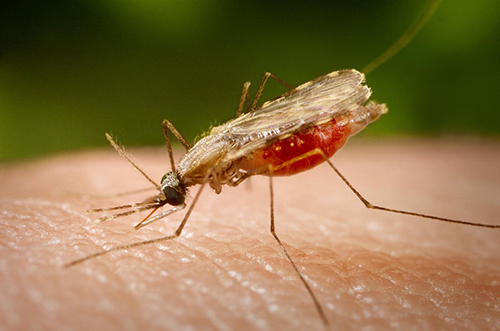Atlas of Malaria Mosquitoes' Immune System Assembled - Genetic Engineering & Biotechnology News

An international team of scientists led by investigators at the Wellcome Sanger Institute and the NIH has created the first cell atlas of mosquito immune cells to understand how the insects fight malaria, as well as other mosquito-borne infections. The mosquito host is essential for the malaria parasite to complete its lifecycle, so any disruption would dramatically reduce the transmission of one of the world’s deadliest diseases.
Findings from the new study—published recently in Science through an article titled “Mosquito cellular immunity at single-cell resolution“—discussed the discovery of new types of mosquito immune cells, including a rare cell type that could be involved in limiting malaria infection. The authors also identified molecular pathways implicated in controlling the malaria parasite.
“We have carried out the first-ever large-scale survey of the mosquito immune system, and using single-cell sequencing technology, we found immune cell types and cell states that had never been seen before,” explained lead study investigator Gianmarco Raddi, PhD, a postdoctoral researcher at the Wellcome Sanger Institute. “We also looked at mosquitoes that were infected with the Plasmodium parasite, and, for the first time, we’re able to study their immune response in molecular detail, and identify which cells and pathways were involved.”
Malaria is a life-threatening disease that affects more than 200 million people worldwide and caused an estimated 405,000 deaths in 2018 alone, the majority of which were children under five. It is caused by Plasmodium parasites, which are spread via the bites of female Anopheles mosquitoes. Breaking the chain of transmission from human to mosquito to human is key for reducing the burden of malaria.
The current study findings offer opportunities for uncovering novel ways to prevent mosquitoes from spreading the malaria parasite to humans and potentially eliminating malaria transmission. The atlas will also be a valuable resource for researchers trying to understand and control other mosquito-borne diseases such as Dengue or Zika.
The mosquito immune system controls how the insect can tolerate or transmit parasites or viruses; however, little is known about the exact cell types involved. In this first in-depth study of mosquito immune cells, a team of researchers studied two types of mosquito: Anopheles gambiae, which transmits malaria, and Aedes aegypti, which carries the viruses that cause Dengue, Chikungunya, and Zika infections.
Using cutting edge single-cell techniques, the researchers analyzed more than 8,500 individual immune cells to see exactly which genes were switched on in each cell and identify specific molecular markers for each unique cell type. The team discovered there were at least twice as many types of immune cells than had previously been seen and used the markers to find and quantify these cells in circulation or on the gut and other parts of the mosquito. They were then able to follow how Anopheles mosquitoes and their immune cells reacted to infection with the Plasmodium parasite.
“We profiled the transcriptomes of 8,506 hemocytes of Anopheles gambiae and Aedes aegypti mosquito vectors,” the authors wrote. “Our data reveal the functional diversity of hemocytes, with different subtypes of granulocytes expressing distinct and evolutionarily conserved subsets of effector genes. A previously unidentified cell type in An. gambiae, which we term “megacyte,” is defined by a specific transmembrane protein marker (TM7318) and high expression of lipopolysaccharide-induced tumor necrosis factor–α transcription factor 3 (LL3). Knockdown experiments indicate that LL3 mediates hemocyte differentiation during immune priming. We identify and validate two main hemocyte lineages and find evidence of proliferating granulocyte populations.”
Interestingly, a previous study from the NIH team had shown that a process called immune priming could limit the ability of mosquitoes to transmit malaria, by activating the mosquito immune system to successfully fight the parasite. In this study, the researchers discovered that one of the newly discovered immune cell types had high levels of a key molecule needed for immune priming and could be involved in that process.
“We discovered a rare but important new cell type we called a megacyte, which could be involved in immune priming, and which appears to switch on further immune responses to the Plasmodium parasite,” noted co-senior study investigator Oliver Billker, PhD, a former senior group leader at the Wellcome Sanger Institute and now based at Molecular Infection Medicine Sweden, Umeå University. “This is the first time a specific mosquito cell type has been implicated in regulating the control of malaria infection and is a really exciting discovery. We now need to carry out further studies to validate this and better understand these cells and their role.”
Finally, the researchers showed that specific types of immune cell—granulocytes—increased in number in response to infection and revealed that some of these could develop into other immune cells. They also discovered that immune cells in the mosquito’s gut and other tissues are actively recruited into the circulation to fight infections after lying dormant on the mosquito fat body.
“The team has created the first mosquito immune cell atlas, to shed light on how mosquito immune systems fight infections. Mosquitos appear to have a sweet spot of immunity to parasites like malaria, with enough immunity to the infection that it doesn’t kill the mosquito but not enough to remove the parasite, concluded study co-author Sarah Teichmann, PhD, a group leader at the Wellcome Sanger Institute. “This atlas offers a vital resource for further research, which could reveal ways to modify the mosquito immune response to break the chain of disease transmission.”

Comments
Post a Comment